As a new cyclist, one of the BIGGEST choices you have to make is what shoes will I wear? Unfortunately, depending on how you answer the question – there will be more questions. Some of them may actually be scary as answering the question a certain way will result in your feet being “attached” do your bicycle. My goal in this article is to help you answer the questions and help you get past any fear or anxiety. Let’s start from the beginning!
What shoes should I wear for cycling?
The answer is simple – cycling shoes! The reason is simple, cycling shoes are stiffer than most shoes you own. They are designed to push on a pedal and not flex, putting all the power into the drive train. Any flex in your shoe is a waste of energy, but more importantly – your foot does not like flexing that way. It leads to sore feet and hotspots on your feet that are very uncomfortable. There is no doubt in my mind that a good fitting pair of cycling shoes can/will enhance your cycling experience.
What kind of shoes should I wear?
Two things come into play here – Fit and Type. Fit is the most important thing. Your shoes need to fit and be comfortable or you will be uncomfortable and focussed on your feet, not on enjoying your ride. Shoes should fit snuggly, but be comfortable. No need to cram your feet in smaller shoes or any such lunacy!
Now what type? You will have to make a decision here. I’m not going to tell you what you need – I’m going to tell the pros and cons – and let you make the decision. I’ll also share my choice.
Road Shoes: Road shoes are made for road cycling, which rarely involves any walking. They are not designed for walking. They are characterized by stiff sole with a larger cleat mounted to the ball of the foot. The cleat is NOT recessed. Walking in road shoes involves a “toe-up” step with a “clip-clop” sound. You are able to walk around, get to your bike and stuff, but it’s not comfortable. Walking will also wear out your cleats. In general, road shoes will require a clipless pedal (more on pedals in a few minutes). Your pedal choice on road shoes will be much larger – and in general allow a larger platform to “push on”, based completely on the size of the cleats. The larger platform can help prevent hot-spots on your feet, but isn’t necessary. My personal preference is road shoes/pedals.
Pros:
- More pedal choices
- Larger contact area with pedal
Cons:
- Harder to walk
- Cleats wear out when walking
Mountain Bike Shoes: Before I get started, there are some touring and/or spin shoes on the market now that are not as aggressive as mountain bike shoes. They, in general, offer all of the same features I’m about to discuss. There’s very little differentiation, so let’s talk about them all together. This class of shoes has a “tread pattern” similar to a running or hiking shoe. Large, rubber lugs allow you to walk “comfortably” as the cleat is actually recessed. There is some degradation in comfort as the shoes don’t flex. That being said, they are much better than road shoes. Now, the cleat on these shoes is a little bigger than a quarter and made out of metal. It is hidden between a few large lugs of sole near the ball of the foot. Please note, it MAY actually touch the ground when walking, so you probably don’t want to run around on your hardwood floors. Unlike road shoes, you could use mountain bike shoes on regular pedals, or with toe-clips. They are a great option for mountain bikers or recreational cyclists.
Pros:
- You can walk
- You can ride without clipless pedals
- Cleats are metal and rarely wear out
- With right pedals, same shoes can be used for spinning
Cons
- Smaller pedal contact patch
- Can be a little tricker to clip in
I hope I’ve painted a picture that allows you to make your best decision. I’ve found more serious road cyclist prefer road shoes. The rest of the world enjoys mountain bike shoes!
What pedals should I use?
I use Shimano SPD-SL pedals and love them. They only work with road shoes – now let me break down your choices:
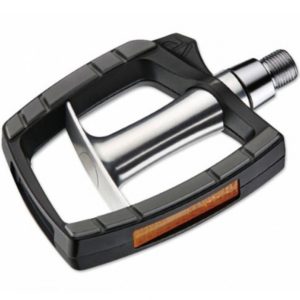 Standard Platform Pedals: These are your most BASIC pedals. You put your feet on them and they work. You can jump on them with your running shoes or a pair of mountain bike shoes and pedal. The problem is your foot will move around a lot. This will be cumbersome and ultimately lead to more fatigue. Should you chose this type of pedal, I highly recommend getting some toe-clips and straps.
Standard Platform Pedals: These are your most BASIC pedals. You put your feet on them and they work. You can jump on them with your running shoes or a pair of mountain bike shoes and pedal. The problem is your foot will move around a lot. This will be cumbersome and ultimately lead to more fatigue. Should you chose this type of pedal, I highly recommend getting some toe-clips and straps.
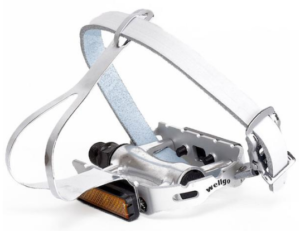 Toe-Clips and Straps: The classic set up. It offers you the ability to ride on the “bottom” of the pedals or put your foot in the toe-clips and straps. In the old days, we would snug the straps down to hold our feet in there. You do NOT need to do that, rather you can allow the clips and straps to hold your feet in place, eliminating the slip I mentioned earlier. It does take a little practice to pull your foot back, but it’s really an easy thing to train yourself on!
Toe-Clips and Straps: The classic set up. It offers you the ability to ride on the “bottom” of the pedals or put your foot in the toe-clips and straps. In the old days, we would snug the straps down to hold our feet in there. You do NOT need to do that, rather you can allow the clips and straps to hold your feet in place, eliminating the slip I mentioned earlier. It does take a little practice to pull your foot back, but it’s really an easy thing to train yourself on!
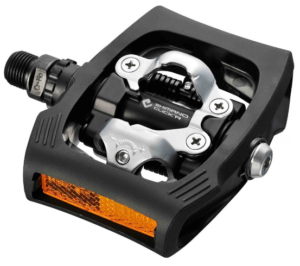 Hybrid Pedals: These pedals, I am putting in the middle – because they are part platform – part clipless. They are a GREAT solution for new clipless users as they can chose to use the clip-in feature when they want to, and opt out when they aren’t comfortable. These are only good with mountain bike shoes, but they offer a GREAT solution for recreational cyclists!
Hybrid Pedals: These pedals, I am putting in the middle – because they are part platform – part clipless. They are a GREAT solution for new clipless users as they can chose to use the clip-in feature when they want to, and opt out when they aren’t comfortable. These are only good with mountain bike shoes, but they offer a GREAT solution for recreational cyclists!
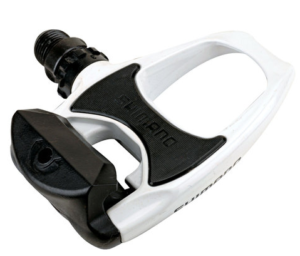
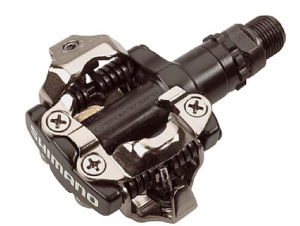 Clipless Pedals: I cannot capture all of the pedal options in photos! These are the best pedals for cycling, as they allow you to “clip in” and they hold your feet in place. This MAY SOUND SCARY – but they also disengage almost instantly when you fall off your bike. I have heard a story or two of people getting a twisted ankle, but generally I believe clipless pedals to be COMPLETELY safe. Mountain or touring oriented pedals are typical dual sided, allowing easier clip-in. (Speedplay road pedals are dual sided as well). Most pedals, you “shove your toe in” and then push your heal down to clip in. To get out, you simply push your heal to the outside. This DOES take some practice, but that’s what riding your bike is – practice!
Clipless Pedals: I cannot capture all of the pedal options in photos! These are the best pedals for cycling, as they allow you to “clip in” and they hold your feet in place. This MAY SOUND SCARY – but they also disengage almost instantly when you fall off your bike. I have heard a story or two of people getting a twisted ankle, but generally I believe clipless pedals to be COMPLETELY safe. Mountain or touring oriented pedals are typical dual sided, allowing easier clip-in. (Speedplay road pedals are dual sided as well). Most pedals, you “shove your toe in” and then push your heal down to clip in. To get out, you simply push your heal to the outside. This DOES take some practice, but that’s what riding your bike is – practice!
In a soon to be published article, I’ll give you some tips and tricks to safely use your clipless pedals! It can be intimidating, but starting slow and understanding how they work can make everything better!